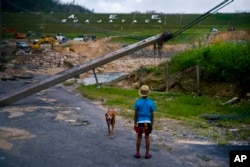Puerto Rico's governor announced Monday that he is moving to privatize the U.S. territory's public power company after its slow, troubled recovery from Hurricane Maria focused new attention on longstanding accusations of mismanagement and corruption.
Nearly 30 percent of customers on this island of 3 million people remain without power more than four months after Hurricane Maria. Many blame the failings of the Puerto Rico Electric Power Authority, or PREPA.
Its director was forced out in November after the utility failed to immediately call for help from its mainland counterparts after the storm. Instead PREPA granted a power-restoration contract to a little-known company that the utility was later forced to rescind. Most recently, PREPA was blamed for the failure to distribute badly needed parts found in one of its warehouses even as repairs went undone for lack of supplies.
Founded in 1979 as a public utility run by appointees of the island’s governor, PREPA is roughly $9 billion in debt and years before Maria’s September landfall the company was criticized for political patronage and inefficiency. It was also beset by frequent blackouts, including an island-wide outage in September 2016.
“The Electric Power Authority has become a heavy burden for our people, who today are held hostage by its poor service and high cost,” Gov. Ricardo Rossello said. “The deficient and obsolete system of generation and distribution of energy is one of the great impediments to our economic development.”
Because PREPA is bankrupt, a federal judge will have to approve the sale, in addition to the island’s legislature, economists said.
In the next couple of days, government officials will begin working with legislators to begin defining how to sell the utility’s assets. Some leaders of Puerto Rico’s Senate said they would support the measure while the body’s president said he still needed to evaluate the plan. House leaders did not immediately respond to the proposal.
Rossello said privatization would bring more affordable rates and better service to consumers and help attract more business to an island mired in an 11-year-old recession.
But Sen. Juan Dalmau, whose party supports independence for Puerto Rico, said privatization would not necessarily translate into efficiency or savings.
“The message is a manipulation of the justified hopelessness of an island facing a lack of power after the hurricane,” he said.
Neither union leaders nor a spokesman for the utility immediately returned calls for comment.
Rossello said PREPA’s electrical grid is not designed for Puerto Rico’s current needs, noting that the greatest demand exists in the northern part of the island, while the main generation plants are in the south. Rossello said PREPA’s infrastructure is nearly 30 years older than the industry average. The company has lost 30 percent of its employees in the last five years, 86 percent of whom worked in maintenance, he said.
“With this transformation of PREPA, you will cease being its hostage,” he said.










